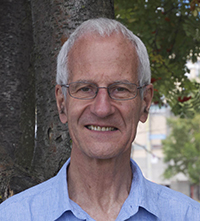Robert Griffiths, University of Oxford
Le mercredi 9 octobre 2013 • 19h30
Wednesday, October 9, 2013 • 7:30 pm
LIEU/VENUE :
Université de Montréal
Pavillon Jean-Coutu
2940, chemin de Polytechnique
salle S1-151
The Mathematics of Evolution
Résumé : Genes are transmitted randomly: this is why probability, a branch of mathematics, is used to model evolution within species. The lecture will give a non-technical overview of some models and explain the two-way interaction between mathematics and population genetics. Starting with the famous model of Wright-Fisher in the 1930’s, it will move to the revolutionary way of looking at evolution introduced by Kingman in 1982: instead of looking forward in time, we look backward! DNA data became available in the last decades and statistics now plays a crucial role in determining the ancestral trees back in time. A stunning application is the identification of hotspots of recombination, where chromosomes are more likely to break on reproduction.
La conférence sera suivie d'un vin d'honneur à l'Agora Goodman.
Biography: Robert Griffiths received his Ph.D. in Mathematical Statistics from the University of Sydney in 1970. He was a Lecturer at Macquarie University, Australia, 1970--1973; then Lecturer - Reader at Monash University, Australia, 1973--1988; and Lecturer - Professor at Oxford University 1998--2011 where he is now an Emeritus Professor. He was elected as a Fellow of the Royal Society in 2010. His research area is in Mathematical Population Genetics, particularly in diffusion processes, coalescent theory, gene trees and ancestral inference.
He is visiting the CRM in 2013 as a Clay Senior Scholar for the Thematic Semester in Biodiversity and Evolution.
Biographie: Robert Griffiths obtient son doctorat en statistique mathématique de l'université de Sydney en 1970. Il est conférencier au Macquarie University en Australie (1970-1973), puis conférencier - lecteur au Monash University en Australie (1973-1988); enfin, il est conférencier - professeur à l'université de Oxford de 1998 à 2011 où il est maintenant professeur émérite. Il a été élu membre de la Société royale en 2010. Les mathématiques de la génétique des populations est son domaine de recherche, en particulier, les processus de diffusion, la théorie coalescente, les arbres génétiques et l'inférence ancestrale.
Il visite le CRM en 2013 à titre de Clay Senior Scholar à l'occasion du semestre mathématique en biodiversité et évolution.

